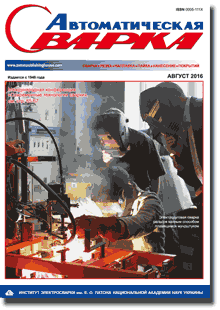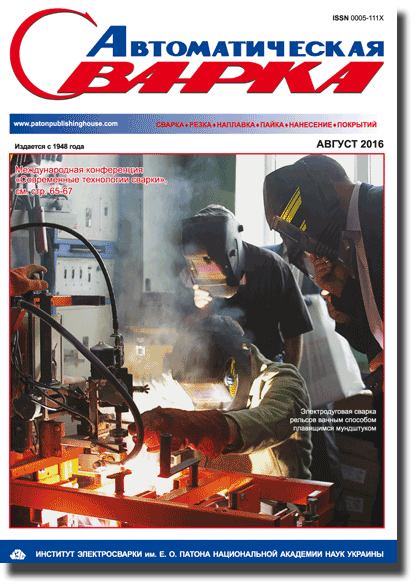| 2016 №08 (02) |
DOI of Article 10.15407/as2016.08.03 |
2016 №08 (04) |

Avtomaticheskaya Svarka (Automatic Welding), #8, 2016, pp. 15-20
Improvement of crack resistance of banded supporting rolls at high-speed surfacing with low heat input
S.V. Shchetinin
Priazovsky State Technical University, 7 Universitetskaya Str., 87500, Mariupol, Ukraine. E-mail: schetininSergey2012@yandex.ua
Abstract
Improvement of crack resistance of banded supporting rolls is an urgent problem. The work is a study of the mechanism of improvement of deposited metal crack resistance with the aim of development of the process of high-speed surfacing of supporting rolls with low heat input. The method of X-ray structural analysis in diffractometer DRON-3 revealed that the electrode shape and heat input at surfacing have a considerable influence on microdistortions of crystalline lattice, which are responsible for microstresses. The latter lead to intensive formation and propagation of cracks, their initiation mechanism being associated with dislocations. Established regularities were confirmed at measurement of dislocation density by broadening of X-ray lines. Minimum crystalline lattice microdistortions, microstresses and dislocation density are achieved in surfacing with wire and composite electrode at a high speed and with minimum heat input. At increase of surfacing speed and lowering of heat input the rate of heating, cooling and solidification of liquid metal in the weld pool becomes higher, that provides microstructure refinement and increase of deposited metal crack resistance. A process of high-speed surfacing of banded supporting rolls with low heat input was proposed, providing an increase of crack resistance and preventing band failure. 13 Ref., 1 Table, 6 Figures.
Keywords: high-speed surfacing with low heat input, crystalline lattice microdistortions, microstresses, dislocation density, welding stresses, crack resistance, banded supporting rolls
Received: 26.10.16
Published: 03.10.16
References
- Frumin, I.I. (1961) Automatic electric arc surfacing. Moscow: Metallurgiya.
- Frumin, I.I., Reznitsky, A.M. (1975) Application of dispersion-hardened steel for surfacing of primary mill rollers. Svarka, 9, 55–57.
- Ryabtsev, I.A. (2004) Surfacing of machine parts and mechanisms. Kiev: Ekotekhnologiya.
- Tylkin, M.A. (1975) Improvement of life of metallurgical equipment parts. Moscow: Metallurgiya.
- Prokhorov, N.N. (1976) Physical processes in metals during welding. Moscow: Metallurgiya.
- Shorshorov, M.Kh., Belov, V.V. (1972) Phase transformations and changes of steel properties in welding. Moscow: Nauka.
- Savitsky, A.M., Savitsky, M.M., Novikova, D.P. (2004) Influence of welding speed and duration of periodical cooling on structure formation in welded joints of hardening steels in arc welding with thermal cycling. The Paton Welding J., 8, 39–43.
- Musiyachenko, V.F., Mikhoduj, L.I., Pozdnyakov, V.D. (1990) Resistance to cold cracking of T-joints of high-strength steel in shielded-gas single-pass welding. Proizvodstvo, 2, 13–15.
- Gorelik, S.S., Rastorguev, L.N., Skakov, Yu.A. (1970) X-ray structural and electrooptical analysis. Moscow: Metallurgiya.
- Myalin, M.I., Sagalevich, V.M., Turygin, V.N. et al. (1988) Influence of thermodeformation cycle on technological strength in surfacing of gray cast iron with bronze. Proizvodstvo, 3, 10–11.
- Finkel, V.M. (1970) Physics of fracture. Moscow: Metallurgiya.
- Ivanov, A.N., Mezhenny, Yu.O., Ostrov, A.E. (1987) Comparative determination of dislocations density in semicrystals by width of X-ray lines and electron microscopic analysis. Laboratoriya, 2, 43–48.
- Bojko, V.S., Shchetynin, S.V., Klimanchuk, V.V. Method of restoration and strengthening of cylindrical parts. 65092 Ukraine. Int. Cl. B 23 K 9/04. Publ. 15.03.2004.
The cost of subscription/purchase order journals or individual articles
| Journal/Currency | Annual Set | 1 issue printed |
1 issue |
one article |
| TPWJ/USD | 384 $ | 32 $ | 26 $ | 13 $ |
| TPWJ/EUR | 348 € | 29 € | 24 € | 12 € |
| TPWJ/UAH | 7200 UAH | 600 UAH | 600 UAH | 280 UAH |
| AS/UAH | 1800 UAH | 300 UAH | 300 UAH | 150 UAH |
| AS/USD | 192 $ | 32 $ | 26 $ | 13 $ |
| AS/EUR | 180 € | 30 € | 25 € | 12 € |
| SEM/UAH | 1200 UAH | 300 UAH | 300 UAH | 150 UAH |
| SEM/USD | 128 $ | 32 $ | 26 $ | 13 $ |
| SEM/EUR | 120 € | 30 € | 25 € | 12 € |
| TDNK/UAH | 1200 UAH | 300 UAH | 300 UAH | 150 UAH |
| TDNK/USD | 128 $ | 32 $ | 26 $ | 13 $ |
| TDNK/EUR | 120 € | 30 € | 25 € | 15 € |
AS = «Automatic Welding» - 6 issues per year;
TPWJ = «PATON WELDING JOURNAL» - 12 issues per year;
SEM = «Electrometallurgy Today» - 4 issues per year;
TDNK = «Technical Diagnostics and Non-Destructive Testing» - 4 issues per year.





